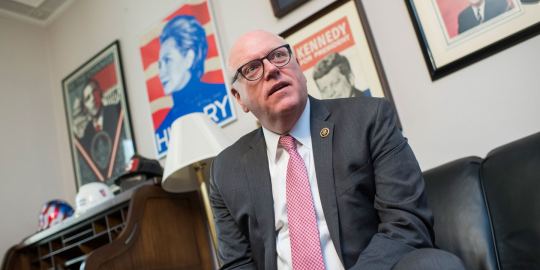#but local democrats did apparently do pretty well at convincing voters to turn out to do write-ins!
Text
The NYT dashboard for the Democratic Primary is so funny because it's just "Gee, wonder who all these unprocessed write-ins are for," but most importantly, my man Vermin has a whole nineteen* votes 😌 Please appreciate this photo of me with Vermin Supreme from the era of terrible snapchat filters (aka the New Hampshire primary 2016)

*481 as of 12:52 AM EST. Yes I will continue to update this post. 😌
#look at all the hope and joy in my eyes. wish I remembered what that was like. lmfao#if you are not following the democratic primary there are shenanigans happening with the dnc and new hampshire#so biden is not actually on the ballot there lmfao#but local democrats did apparently do pretty well at convincing voters to turn out to do write-ins!#I would KILL to be in new hampshire rn to do some analysis on that ngl. god. cuz write ins are HARD#I do think it's more of a pride thing cuz it's really all about the optics of 'first primary in the nation'#and obvs it helps that it's. literally the president. but I digress#uspol
30 notes
·
View notes
Link
Jared Kushner loved Michael Moore’s health care crisis documentary Sicko. He loved it so much that he threw an after-party for it following the film’s premiere in 2007. The future son-in-law of and senior adviser to the future president effusively praised Moore to a reporter, singling out the filmmaker’s ability to construct a compelling argument and bring important issues in American life to light.
A clip of Kushner’s salute to Moore appears early in the documentarian’s latest feature, Fahrenheit 11/9, which made its debut at the 2018 Toronto International Film Festival to an exuberant crowd on Thursday night. Red bandanas were handed out at the door — late in the film, Moore calls for audiences to readopt the red bandana as a symbol, in the spirit of those worn by miners in support of unions in the 1920s — and someone in the crowd shouted, “Michael for president!”
The thing is, Kushner was right. Moore argues for his left-leaning political views passionately and forcefully, often building his case by mixing damning archival footage and expert interviews with his own goofy antics and sly commentary. The effect is something of a gale force, sweeping you along and compelling you to nod your head, without a lot of time to wonder what’s been left off the screen.
It’s effective, and Moore’s sources as embedded in his narrative are generally reliable. But it can feel loose and free-associative in some ways, and Moore’s injection of his own persona into his films — especially the smug snark of his commentary and the affected cluelessness he uses as an interview technique — can get old very quickly.
So his films are by turns convincing and infuriating, and more recent offerings have inspired tepid reviews even from critics who share his political views. His 2017 one-man Broadway show, The Terms of My Surrender, leaned into the worst of these tendencies and garnered flat-out bad reviews, in a city where his political leanings might be assumed to be shared by most of the audience. With Moore, mileage greatly varies.
In particular, self-mythologizing has always been his Achilles heel, so there was a great deal of eye-rolling among critics in June, when the title of his next project was announced to be Fahrenheit 11/9 — a reference to his 2004 documentary Fahrenheit 9/11, which criticized the George W. Bush administration and the War on Terror. That film won the Palme d’Or at Cannes and became the highest-grossing documentary of all time. Was Moore really about to draw a comparison between the events of 9/11/2001 and 11/9/2016 — the day after Donald Trump was elected America’s next president?
He was. But the film is much better than the baggage that comes with its title might imply. Moore still suffers from bouts of self-aggrandizement and snide generalization. But they feel jarringly out of place, and in a good way. That’s because, for a great deal of the film, Moore cedes the floor to people whose voices are not as easily heard, or who have had to fight to have a voice at all.
Fahrenheit 11/9 is a sweeping broadside against Trump, to be sure — not an original approach in documentary filmmaking these days. But it also does what few political films seem willing to do in the Trump era: It powerfully (if unsystematically) dismantles idealistic notions about how much better things were before Trump took office.
The film’s news peg may be the current administration, but its target is self-satisfied liberals who more or less trust the system. Early on, Moore even implicates himself, offering up a series of mea culpas for people he’s hobnobbed with in the past — Kushner, Steve Bannon, Kellyanne Conway, and Trump himself (on Roseanne Barr’s talk show, no less).
And when Fahrenheit 11/9 does turn to the election itself, it’s less interested in Trump as cause and more as symptom of nationwide disillusionment, money-driven elections, and a resulting apathy about the political process. (Forty percent of eligible Americans didn’t even vote in the 2016 election.)
Moore sprays water from Flint, Michigan, on Gov. Rick Snyder’s mansion in his new documentary Fahrenheit 11/9. Courtesy of TIFF
Moore goes after everyone close to the president, even insinuating early on that there is something very inappropriate about his relationship with his daughter Ivanka. He even winds up not just comparing Trump to Hitler, but layering one of Trump’s speeches atop video of one of Hitler’s. But he reserves his most angry, pointed, and well-constructed criticisms for what he paints as a toothless, crony-driven Democratic establishment and — in a turn that might surprise some viewers — Barack Obama, and particularly Obama’s visit to Flint, Michigan, in 2016.
Moore is from Flint, and the best sequences in Fahrenheit 11/9 are about the city’s ongoing water crisis as well as the political situation that led to it, as more or less engineered by Republican Gov. Rick Snyder, whom Moore repeatedly calls a “criminal.”
At the Fahrenheit 11/9’s Toronto premiere, there were audible gasps in the theater many times, but perhaps the loudest one came when the film detailed how Snyder ordered that the water supply for Flint’s General Motors factory be switched back to clean water because it was corroding auto parts — while leaving the population with a contaminated supply that the government continued to insist was totally fine to drink, despite overwhelming evidence to the contrary.
The Flint section of the film is infuriating but also illuminating; Moore lets whistleblowers, doctors, residents, and local law enforcement vent their anger while also drawing a line between Snyder and Trump that is, at minimum, disturbing.
But he has a larger point. There’s optimism woven throughout Fahrenheit 11/9, borne out of Moore’s conviction that on the whole, the American people (“us,” as he says in the film’s narration, knowing who his audience is) hold progressive views that are more in line with the left-leaning end of the political spectrum than anything Trump represents. (He supports this belief with a raft of polls on health care, taxes, gun control, immigration, abortion, and other matters, mostly from 2018.)
If democracy worked in America, he suggests — if people really felt that their vote meant something — then perhaps the nation could travel down a path that would lead somewhere positive.
Moore dutifully attacks the idiosyncrasies of the system, like the Electoral College and the Democratic Party’s system of superdelegates. But he seems pretty sure that it’s actually activism from the bottom up that will change the country. And so in addition to his own activism in Flint, he spotlights the Parkland, Florida, teens and the March for Our Lives movement and the teachers’ strikes that began in West Virginia and spread to other states.
Is he right? It’s too early to tell. After infusing a solid stretch of Fahrenheit 11/9 with hope, clearly seeking to inspire the audience to actually believe things can change, Moore returns to a more somber tone. He reminds viewers of the apparently enlightened and free-thinking historical context into which Adolf Hitler stepped, less than a century ago, and his thesis is clear: It — meaning the dehumanization of large groups of citizens and devotion to a charismatic strongman leader — can happen here, and it may already have happened.
As a film, Fahrenheit 11/9 is flawed. The movie feels at times more like a crash course in what’s happened since 2016, a kind of “worst hits” album desperate to hit every possible point and draw them all into a unifying theory.
We get Trump, Steve Bannon (“I don’t agree with [Moore’s] politics,” Bannon is shown saying, “but I think he makes a great film”), birtherism, the Central Park Five, Roger Ailes, Bill O’Reilly, Mark Halperin, Matt Lauer, Charlie Rose, Roseanne, “the media” (and especially the New York Times), Trump’s “treasonous” meeting with Putin in Helsinki in July 2018, Bill Clinton, Bernie Sanders, Flint, Parkland, Obama, Nancy Pelosi, Colin Kaepernick, Nazis, and Gwen Stefani, whom Moore insists is the reason Trump ran for president in the first place. (It was, according to Moore, Trump’s discovery that Stefani made more money on The Voice than he did on The Apprentice that made Trump announce his candidacy, to goad NBC into seeing how popular he was. It backfired, but the wheels started turning.)
That’s all crammed into about two hours, and the whiplash is considerable. It’s possible that Moore was trying to mimic the chaos of the news cycle over the past couple of years, but much of the film doesn’t stick so much as leave you with a lot of feelings.
At times, it seems as though some important issues have been wrapped into an argument against Trump because Moore isn’t sure people would have cared otherwise. (Whether or not he’s right, I can’t say.) I especially found myself wishing that, given Moore’s stature among socially conscious audiences as well as his personal connection to Flint, that he had spent less time writing clever zingers about the president and instead made an entire feature film about Flint alone, digging more deeply into its problems and their potential solutions.
Michael Moore speaks with Parkland teenager David Hogg in Fahrenheit 11/9. Courtesy of TIFF
Still, whenever he steps out of the way and hands over the microphone to those without household name recognition, Moore is an effective filmmaker. He knows who to talk to, and he doesn’t focus only on the big names. Voters and public school teachers in West Virginia; an Iraq war vet and various left-wing candidates running for Congress (including Alexandria Ocasio-Cortez and Rashida Tlaib); the last living Nuremberg prosecutor; whistleblowers and doctors and parents and residents in Flint; and many more individuals who don’t grab headlines quite as easily as Trump are all part of Fahrenheit 11/9. With their aid, Moore weaves a tapestry not of hope, but optimistic outrage.
Fahrenheit 11/9 is not going to convince any Trump loyalists to reconsider. But it has no interest in doing that. #NeverTrump conservatives aren’t likely to watch the film either, even though it may offer them some surprising common ground, despite the fact that Moore’s critique of the Democratic Party comes from his democratic socialist views.
Instead, the film concentrates on not letting its more natural audience off easy. It criticizes the easy generalizations, ahistoricity, and even tribalism of a liberal audience (the critiques of Obama and of Clinton, in particular, don’t hold anything back). It suggests the country is a wreck not because of those other people out there, but because the people in the theater itself aren’t even committed enough to their own ideals to get uncomfortable and do something — unlike, for instance, the West Virginia teachers who stayed on strike after their union leaders came to a compromise they wouldn’t accept, or the teenagers who organized the March for Our Lives.
Moore with a group of teens who organized the “March for Our Lives” in Parkland, Florida. Courtesy of TIFF
That means there’s something in this film to irritate everyone. And it’s certainly true that a more focused approach may have ultimately been more effective at dismantling his opponents. After all, everything Moore says has been out there, publicly reported by “the media” for years, and it’s the barrage of information that has sent a lot of people into a spiral of apathy, overwhelmed by everything that needs doing and everything that is awful. Do we need more outrage in 2018?
Moore thinks America does need more outrage — but more focused outrage. It’s useless to hate on Trump, he posits. What we need to do is to “get rid of the whole rotten system that gave us Trump,” as he declares toward the end of Fahrenheit 11/9. And that effort, to him, will start with the “real” America, the people to whom he’s increasingly handing the microphone.
Fahrenheit 11/9 premiered at the Toronto International Film Festival in September and opens in theaters on September 21.
Original Source -> In Fahrenheit 11/9, Michael Moore spares no one — especially self-satisfied liberals
via The Conservative Brief
0 notes
Text
Alexandria and the Optimistic, Game-Changing, Pretty Sweet, Very Good Play

By now, most people who follow politics know the name Alexandria Ocasio-Cortez. On June 26 during New York’s congressional primaries, the 28-year-old community organizer pulled a surprise upset against incumbent U.S. Congressman Joe Crowley – the fourth-ranking Democrat in the House leadership who has been serving in Congress for nearly two decades.
According to Michael Kinnucan of Jacobin magazine, Ocasio-Cortez's dark horse candidacy came to fruition due to a number of factors. Her electrifying campaign style and interpersonal presence mobilized her grassroots supporters, who turned out in droves for what would have otherwise been considered a sleepy, uneventful congressional primary in a reliably-Democratic district. Also, Crowley's influence within the Democratic Party didn’t translate to loyalty from his constituents of New York’s 14th District. The hybrid Bronx/Queens congressional district is largely composed of people of color, who were persuaded by the massive volunteer force upon which Ocasio-Cortez relied to disseminate her message.

Kinnucan also credits the Democratic Socialists of America (DSA) for helping the Ocasio-Cortez campaign go viral in the final weeks of the campaign. In turn, they had raised enough money (roughly $100,000) to utilize necessary campaign infrastructure. Crowley's perceived tone-deafness by his constituents did the rest. In the end, she edged out Crowley by a difference of 4,000 votes (out of 27,000+ total votes cast)...which, although sounding narrow on paper, actually translated to a margin of fifteen percentage points separating the two of them.
If you look at Alexandria Ocasio-Cortez’s platform, much of what she champions overlaps with the 2016 presidential platform of Bernie Sanders. Some of it creeps into the Venn diagram occupied by the much-maligned Green Party candidate Jill Stein.

Ocasio-Cortez supports Medicare-For-All, an assault weapons ban, increased housing tax credits, and a federal jobs guarantee. She mirrors Elizabeth Warren in her desire to see Glass-Steagall reinstated...and even goes so far as to embrace Stein’s platform plank of student debt cancellation. Her stances emphasize the working class over the wealthy, as she seeks to raise the taxable income cap on Social Security and crack down on corporate lobbyists (specifically with full donor disclosure laws, until the point when Citizens United can be overturned).
When it comes to social issues, she also sings the tune of self-identified progressives. Ocasio-Cortez is a strong voice of criminal justice reform, passing the DREAM Act, protecting reproductive rights, advancing LGBT equality, and achieving gender pay equity. Her environmental platform emulates the “Green New Deal” touted by Jill Stein during Stein’s third-party presidential run.

Some of Ocasio-Cortez’s stances might be a harder sell when it comes to federal legislation. She is pushing for tuition-free college and the abolition of ICE. Without question, moderate Democrats and many centrists won’t be too keen on acquiescing to these positions.
But serving in Congress is about compromise and incrementalism. Ocasio-Cortez knows this. Much like Sanders and Stein, she is conceivably attempting to set the bar really high so that any future legislative reconciliation process will end up with more favorable results (in the eyes of progressives) than past sessions of Congress.

Her personal story is extremely captivating. Ocasio-Cortez was born to a working-class Bronx family. Puerto Rican on her mother’s side, as a young girl and a teenager she commuted 40 minutes to a public school in Yorktown – a Westchester County suburb that provided her a much more advantaged education than if she had attended school in her local urban New York City neighborhood.
During her young adulthood, Ocasio-Cortez was a congressional caseworker (focusing on immigration) in the office of the late U.S. Senator Ted Kennedy (D-MA). Beyond that, she worked with youth mentoring and literacy programs back in her home district. Her father was diagnosed with cancer during The Great Recession, and she had to work double-shifts in restaurants to help her family pay his medical bills.

Alexandria Ocasio-Cortez channeled her life experiences and occupational knowledge as a working class Latina woman...and inspired legions of supporters to help her bring change to the 14th District. But as she moves on to the General Election, additional hurdles await her.
New York allows candidates to run on multiple party lines for the General Election ballot, and Crowley had already received the endorsement of the smaller Working Families Party (while simultaneously competing to earn the Democratic Party’s nomination, once again, for his seat). Due to an odd statute within New York state election laws, although Ocasio-Cortez will be the actual Democratic nominee for this seat in November, Crowley apparently isn’t allowed to take his name off the ballot unless he relocates his residence or convinces the WFP to endorse him for a different office. So, as things stand right now, Crowley’s name will remain on the ballot even though he isn’t actively running.

At least, that’s what he says...right now. After losing the primary, Crowley sportively praised Ocasio-Cortez on social media while publicly serenading her with a guitar-accompanied rendition of Bruce Springsteen’s “Born to Run.” Yet, shortly after the primary results became known, former U.S. Senator Joe Lieberman (D-CT) weighed in – publicly imploring Crowley to continue running against Ocasio-Cortez on the WPF line (much the same way Lieberman himself did, back in 2006 – forming his own temporary party and running against Ned Lamont in the General Election after Lieberman had been primaried out by Lamont in the Democratic U.S. Senate primary that year).
In Lieberman’s view, Ocasio-Cortez is a far leftist who is drastically out of the mainstream...even in her very liberal district.

Never mind that Lieberman was a driving force behind why no public health care option ended up in the final version of the ACA back in 2010. Lieberman ran a mealy-mouthed, disingenuous presidential campaign for the Democratic nomination in 2004 – four years after having further tainted the already-corrupt Al Gore presidential campaign with his anemic presence as Gore’s vice-presidential running mate.
Since having retired from the Senate in 2012, Joe Lieberman has spent the better part of his days consulting for white-collar criminal defense attorneys while also moonlighting as part of a few neoliberal think tanks. He supported Betsy DeVos, the controversial Trump-appointed Education Secretary...right before interviewing with Trump for James Comey’s spot as FBI Director. Interesting – given how Lieberman himself had endorsed Hillary Clinton during the 2016 election (even though he’d endorsed John McCain over Barack Obama, eight years earlier).

And, predictably, Fox News and other squawkers from the Far Right have vilified Ocasio-Cortez for her embrace of “Democratic socialism.” They have portrayed her as a leftist caricature...probably because she’s successfully tapping into much of the anger and indignation that fueled Bernie Sanders supporters throughout 2016.
Lieberman and various neoconservatives most likely fear how Ocasio-Cortez represents a potential shift away from blatant favoritism toward Israel – on the foreign policy front – in favor of a two-state solution. But even liberals who are well to the left of Lieberman seem poised to gun for Ocasio-Cortez (once she is inevitably seated in Congress).

The objections to Alexandria Ocasio-Cortez’s congressional candidacy are eerily similar to the huffing-and-puffing over former Sex and the City co-lead Cynthia Nixon’s insurgent gubernatorial challenge to incumbent Andrew Cuomo (running for what would be his third term as Governor) in September’s Democratic primary. Although Nixon is vying to represent the entire state of New York (whereas Ocasio-Cortez would be representing one solitary congressional district located in The Big Apple), the two women have similar underdog stories when challenging the establishment favorites in Crowley and Cuomo.
Quite fittingly, Ocasio-Cortez and Nixon have begun openly campaigning together in the weeks leading up to Nixon’s showdown against Cuomo. Even if Cuomo wins the Democratic gubernatorial nomination on September 13 (as most political observers expect him to), Nixon could go ahead and do exactly what Lieberman and his ilk are “encouraging” Crowley to do...she could run as an Independent gubernatorial candidate on the Working Families Party line.

Many Democrats fear that, if Nixon goes this route, she would split the left-of-center votes with Cuomo...and enable the presumed Republican nominee, Marcus Molinaro, to possibly eke out a plurality victory in November. While this is certainly a possible scenario, it’s equally as likely that Libertarian nominee Larry Sharpe could siphon away right-of-center votes from Molinaro. And then add Independent candidate Stephanie Miner (the former Mayor of Syracuse) to the mix: Miner is running as an Independent with the blessing of the Serve America Movement, which has been attracting moderate Republicans and moderate Democrats alike.
A five-person race between Nixon, Cuomo, Molinaro, Sharpe, and Miner could prove to be both riveting and unpredictable...as this isn’t necessarily your standard midterm election year. And, having aligned herself with Nixon, Ocasio-Cortez appears poised to encourage such a competitive, multi-party scenario.

This is probably why she scares the Andrew Cuomos and the Joe Liebermans and the Fox News hounds alike. They want a continued, black-and-white, two-party duopoly. They don’t want American voters to have a variety of choices. Why do you think they are so resistant to enacting forms of Instant-Runoff Voting?
They fear losing their power and their stranglehold over the current system.
Isn’t it a wee bit hypocritical – and, dare I say, sexist – for people to demand that Nixon bow out of the gubernatorial race in deference to Cuomo...while simultaneously encouraging Crowley to embark upon a sour grapes renegade campaign against Ocasio-Cortez?

However the New York gubernatorial race shakes out, Alexandria Ocasio-Cortez is not going away. Whether or not Joe Crowley proceeds to campaign against her between now and November...she’s released a rabble-rousing genie from its bottle – and that genie isn’t going back in.
I say: Good for her! We need more Alexandria Ocasio-Cortezes in our U.S. Congress. I may not agree with her 100% on every issue. I’m a centrist who seeks middle ground when implementing solutions. But I’m also a centrist who loathes the corruption and narcissism of people such as Joe Lieberman. And, unfortunately for Joe Crowley, he failed to reject that ill-begotten philosophy during his last several terms in the U.S. House of Representatives.

Now all Ms. Ocasio-Cortez needs to do is start talking more about the ignored-yet-pivotal issue of Sustainable Agriculture...and her tenacity could set off a wave that resonates across many states – and multiple party lines – for many election cycles ahead of us.
0 notes